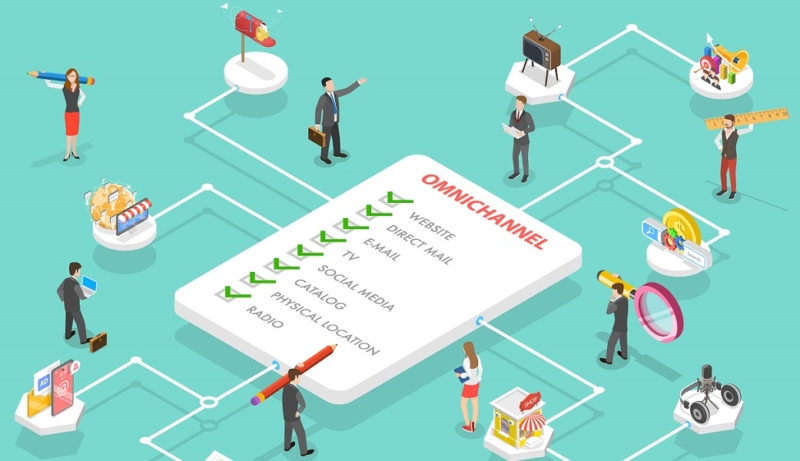Brands need to create a holistic marketing strategy that reaches shoppers when they are online and off.

Online shopping surged during the pandemic. The need to shelter in place changed just about everything about the way we live, work and shop. While e-commerce was already on the rise, COVID-19 made it mainstream.
Statistics Canada summarizes the shift this way: “During the pandemic, e-commerce became essential to ‘non-essential’ businesses.” Online sales for almost everything skyrocketed during the height of the pandemic in 2020. Compared to January 2019, there was 140-per-cent jump in sales of building materials and a 42-per-cent increase in sales of garden equipment and supplies
Not surprisingly, during this period, marketers focused their attention almost exclusively on engaging with customers and target audiences online. Now that the world is learning to live with COVID-19 and many people have gone back to in-store shopping, it’s time to return to an omnichannel online-offline marketing presence.
What is online-offline integration?
Integrating online and offline marketing efforts merges both marketing strategies, maximizing the best of each to reach more people and drive powerful results. Online-offline integration creates a seamless, consistent presence across all marketing channels that puts the customer first. This requires accurate, real-time insights, as well as monitoring and measuring triggers to online and offline conversions. It’s not easy, but when done right, integrating online and offline marketing efforts creates a better experience for the customer, helps them move through their buying journey, boosts brand awareness, and increases online and offline sales.
Benefits of online marketing
- Precise, agile targeting that puts real-time insights to work to increase reach.
- Instant ad delivery via programmatic buying.
- Lower costs than traditional offline advertising.
- The ability to easily measure engagement, performance and conversions.
Benefits of traditional offline marketing (such as print, radio, TV and billboards)
- Long-term exposure.
- The ability to reach secondary audiences and expand influence.
- Enhanced brand awareness. (Unlike digital ads, which are highly constricted by time and space, print and broadcast ads have the luxury of building a brand’s identity and speaking to its values versus highlighting product features.)
Strategies to integrate online and offline marketing
Here are six ways to integrate online and offline marketing to increase both online and offline sales:
1. Create shared objectives for online and offline marketing campaigns
This is all about driving impact and creating a unified experience for your target audience, whether they’re online or off. Start by identifying a shared priority. Then create online and offline campaigns to achieve that objective. For example, if the goal is to increase awareness and purchases of a specific product, simultaneously market the product online and offline. Make sure offline ads direct consumers to the same landing pages and QR codes that digital ads are pointing them to. This will help you track and compare how each campaign is performing.
Tip: Connect online and offline campaigns with custom tracking URLs. When customers visit, you will immediately know where they came from.
2. Focus on relevance
Creating content that will help users is critical for digital ads to rank high on search engines. Understanding what consumers are searching for online and providing information they can use will also help them when shopping offline. This is because most people are researching local businesses from their mobile devices while on the go and are ready to buy offline.
According to Google:
● four out of five consumers use search engines to find local information, such as a store address, business hours, product availability and directions;
● searches for “curbside pick-up” grew 3,000 per cent over the past year;
● 50 per cent of consumers who conducted a local search on their smartphone visited a store within a day and 18 per cent made a purchase that same day; and
● 78 per cent of local mobile searches result in offline purchases.
Check out our guide on how to update your online business profile.
3. Develop connected online-offline promotional strategies
Use online ads to promote offline marketing efforts and offline ads to promote online marketing efforts. For example, if you have a sponsored radio appearance, use social media to let more people know about it. Use creative on print ads to encourage people to take part in a social campaign.
4. Encourage in-store customers to visit your digital properties and online shoppers to visit your physical store
This can be as simple as encouraging in-store customers to participate in an online survey or asking for their email information so they can receive your email newsletter or early access to online promotions. Conversely, create in-store-specific offers and share them on your website to encourage people to visit your store.
5. Make sure design is consistent across all marketing channels and platforms
Design plays a critical role in brand building and recognition. Regardless of where an ad appears, design elements such as colour, font and placement should tell the same visual brand story. Consistent design across all channels will help people remember you.
6. Implement unified marketing measurement
Unified marketing measurement is a framework that uses data to create one clear view of how individual users are interacting with online and offline campaigns. It’s an approach that brings together two key components of marketing analysis: Marketing Mix Marketing, which is used to track the impact of offline marketing on sales and Multi-Touch Attribution, which tracks individual interactions with online campaigns. Start by identifying key performance indicators and the data you need to collect to drive results. Once you have a holistic picture of what’s working and what’s not, you can improve campaigns and better integrate online and offline marketing efforts to maximize ROI.
Hitting the right mix of online and offline marketing campaigns is challenging. It’s also worth it. Online-offline integration uses data-driven insights to deliver better customer experiences that deliver results.


